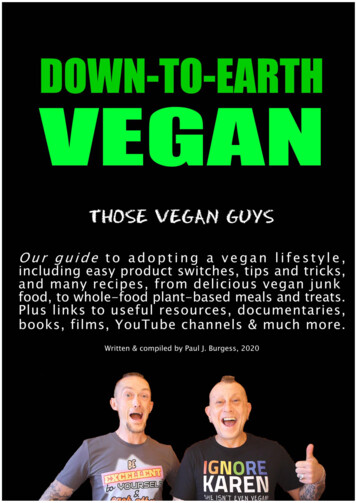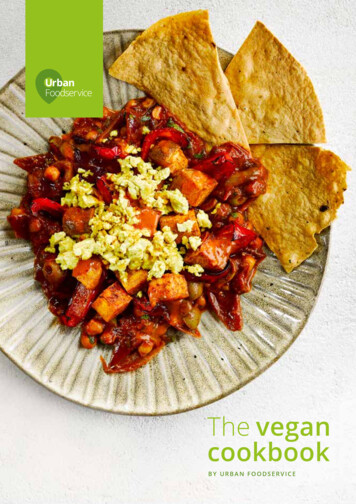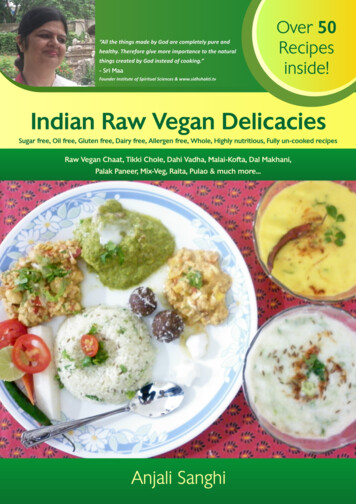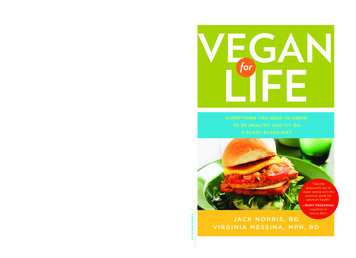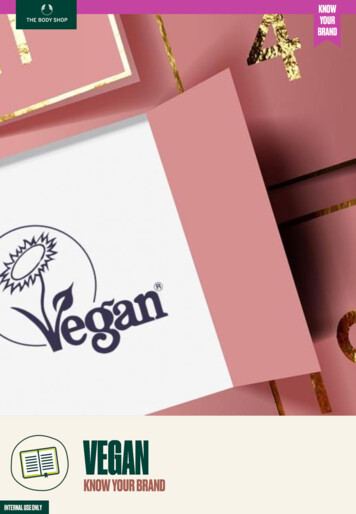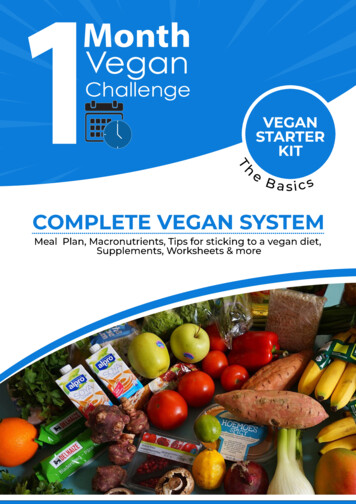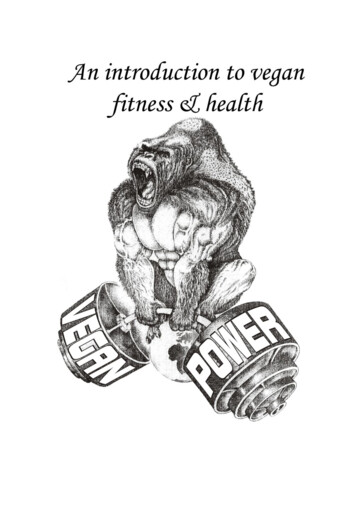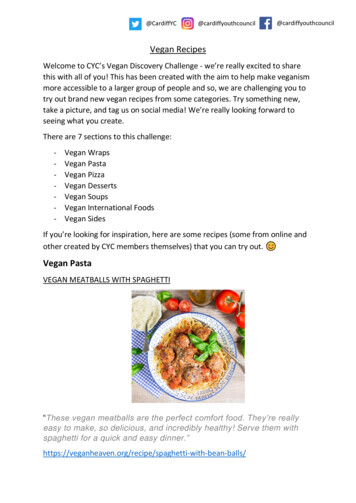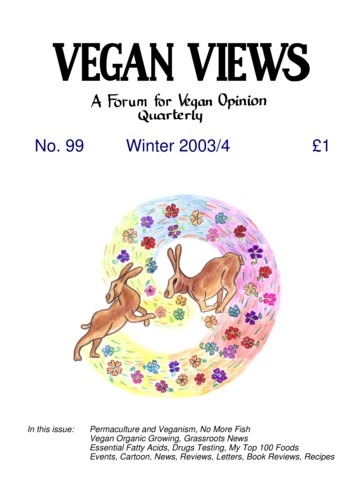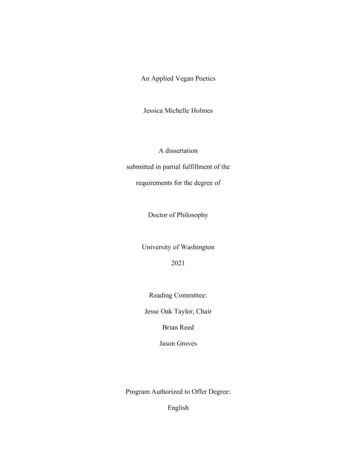
Transcription
An Applied Vegan PoeticsJessica Michelle HolmesA dissertationsubmitted in partial fulfillment of therequirements for the degree ofDoctor of PhilosophyUniversity of Washington2021Reading Committee:Jesse Oak Taylor, ChairBrian ReedJason GrovesProgram Authorized to Offer Degree:English
Copyright 2021Jessica Michelle Holmes
University of WashingtonAbstractAn Applied Vegan PoeticsJessica Michelle HolmesChair of the Supervisory Committee:Jesse Oak TaylorEnglishThis dissertation engages poetic contemplations of nonhuman and human animals in order topropose what I call a vegan poetics: that is, an applied reading/writing practice in service of aninclusive liberatory struggle and by way of imaginative translation, transformation andembodiment of animals. The first chapter charts a definitional inquiry into the framework,situating it within the historical, social and scholarly contexts from which it emerges, andoffering key theoretical and methodological entry points. The subsequent chapters, or “Acts,”then illustrate the concept in action, modelling an applied vegan poetic reading practice using thework of contemporary female poets. Together, my readings of these texts (and the tensions theyilluminate) articulate both the potential and limitations of poetry as an instrument for linguisticand social change. The ambition of my project is to develop a poetic reading/writing practice thatnegotiates the entangled relations between human and nonhuman bodies and dismantles
anthropocentric paradigms of violence deeply entrenched in our culture and scholarship. In orderto achieve this, I argue new forms of language are needed. In this sense, the poet plays animportant role in the project of animal liberation. Through a vegan poetics, the reader is driven tofundamentally reconceptualize human categorization of and coexistence with animal beings,allowing for the poetic transfiguration of commodified objects into living subjects. Bycultivating emancipatory literary practices An Applied Vegan Poetics initiates both imaginativeand material emancipatory action.
TABLE OF CONTENTSIntroduction to a Vegan Poetics9Act One: The Nonhuman Animal42Act Two: The Humanimal Body93Act Three: The Human132Postscript167Bibliography173
DEDICATIONFor those of us who live at the shorelinestanding upon the constant edges of decisioncrucial and alonefor those of us who cannot indulgethe passing dreams of choicewho love in doorways coming and goingin the hours between dawnslooking inward and outwardat once before and afterseeking a now that can breedfutureslike bread in our children’s mouthsso their dreams will not reflectthe death of oursAudre Lorde, ‘A Litany for Survival’
ACKNOWLEDGMENTSThank you to my committee members, Brian Reed, Jason Groves, and especially to my chairJesse Oak Taylor, who never once failed to strike an impeccably supportive balance betweenconstructive criticism and validation of my project. Thank you to my four-legged partner incrime, Jasmine, who kept close company, providing warm-hearted animal presence andcompanionship during the many hours I spent writing and rewriting these pages. Thank you toPasado’s Safe Haven for their work and for allowing me to photograph the beautiful creatures forwhom they care. Thank you to the Department of English at the University of Washington andthe Simpson Center for the Humanities, particularly for financial support through the DonnaGerstenberger Dissertation Fellowship and the Mellon Fellowship for New Public Projects in theHumanities. Thank you to my 2019 Vegan Studies students, who helped me think through manyaspects of a vegan identity and social movement in an academic context. Thank you toAuto/Biography Studies journal for publishing an early version of Act One. Thank you to Natefor endless support and bottomless cups of tea. Finally, thank you to the countless activists,advocates and writers who fought and continue to fight for animal liberation in the face ofenormous obstacles. Until all are free!
Why cannot a body itself be testimony.Ariana Reines
HolmesIntroduction to a Vegan PoeticsThe white fathers told us: I think, therefore I am. The Black motherwithin each of us—the poet—whispers in our dreams: I feel, therefore Ican be free. Poetry coins the language to express and charter thisrevolutionary demand, the implementation of that freedom. Thosedreams are made realizable through our poems that give us the strengthand courage to see, to feel, to speak and to dare.-Audre Lorde, ‘Poetry Is Not a Luxury’There can be no pastoral as long as there is a slaughterhouse.-Gabriel Gudding, Literature for NonhumansI would not have become a vegan if I were not first a reader.Imagination, writes philosopher Maxine Greene, is “a means through which we can assemble acoherent world [and] is what, above all, makes empathy possible. It is what enables us to crossthe empty spaces between ourselves and those we teachers have called ‘other’ over the years”(Releasing the Imagination 3). Indeed each time we pick up a book, we pick up an invitation toperform an exercise in empathy—stepping, through reading, into the perspective of any given“other”; confronting viewpoints beyond the boundaries of our limited lived experience andholding space for alternate realities—past, present and future. In a culture of political division,homogenized discourse and enduring global violence—including violence toward humans,animals and the earthly ecosystems that enable and support life—an exercise in empathycomprises an act of resistance.9
Holmes 10I credit the empathetic imagination—cultivated in large part through reading—withigniting my own early vegan instincts—instincts that led me to question the widely acceptedimplications of the species line. But, as I have learned through years of activism, empathy israrely enough to instigate structural change. A tension arises between liberal conceptions ofliterature as an affectively (and thus socially) transformative apparatus and a radical politicsfocused on direct action as a means of instigating social revolution. This tension is mirrored inthe realm of animal rights, with ecofeminist arguments for an ethic of care contrasting markedlywith rights-based approaches to the moral inclusion of nonhuman animals. While these twopolitical philosophies are by no means mutually exclusive (in fact, I argue the opposite), theyhighlight a dialectical tension germane to questions about the social function of literature.Poetry in particular, I argue, holds the capacity not only to develop the empatheticimagination, but to lay the imperative rhetorical groundwork for formative social transformationwith regard to species relations. We can only demand that which we have the language todescribe. The open field1 of the contemporary poem constitutes a site of linguistic invention.This site welcomes experimentation and rule breaking, a departure from everyday rhetoric, anddoes not necessarily rely on temporal (or causal) configurations of storytelling and knowledgebuilding. The intellectual and epistemological work of poems—as sites of “making”2—isfundamental to breaking down the parameters of existing thought and inventing anew a languageto reflect and bring about the world we desire. Any theory of change, if it is to be successfulbeyond the realm of theory, must recognize normalized hegemonic language (and itsreproduction) as a key structure of the ruling paradigm.12See Charles Olson’s “Projective Verse” (1951) on open verse and composition by field.The word poet derives from the Greek poiētēs (“maker”), from poieō (“to make”) (OED).
Holmes 11It is from the alignment between poetry and veganism as practices of revision (oflanguage, of thought, and of action)—the way in which an imaginative practice of reading mayserve as a vehicle, enabling and activating a mindset and applied practice of nonviolence towardanimal beings—that the occasion for a vegan poetics arises. At the center of this project is aquestion: What can a poem do?More than 70 billion land animals are killed each year (FAO), mostly in industrializedfacilities, commonly referred to as “factory farms.” These dead animals are then processed andpackaged into food, as well as rendered into other industrial products for human use. What can apoem do? Industrial animal agriculture is a leading driver of habitat destruction and speciesextinction. More than one in five species on Earth currently faces extinction, and this number isexpected to rise to 50 percent by the close of the century. Industrial practices have polluted andoverfished earth’s oceans almost to the point of total collapse; if the current rate continues, wemay see fishless oceans by midcentury (Worm et al. 2006). What can a poem do? At my ownhigher education institution, monkeys used for medical experimentation die from starvation,dehydration, strangulation, choking on their own vomit, mauling by other stressed animals, and(of course) euthanasia, at the hands of their human captors. What can a poem do?This dissertation engages poetic modes of contemplating nonhuman (and human)animals, cultivating what I call a vegan poetics: that is, an applied reading/writing practice inservice of an inclusive liberatory struggle and by way of imaginative translation, transformationand embodiment of animals. The applied practice helps readers to thoughtfully negotiate theentangled relationship between human and nonhuman bodies and to dismantle violent paradigmsin which our culture and scholarship are entrenched.
Holmes 12A definitional inquiry into a vegan poetics highlights the problem of language (alongsidelanguage’s emancipatory qualities) and emphasizes the need for new forms of expression.Nowhere does linguistically speciesist binary thinking appear more prevalently in thisdissertation than in my struggle to refer justly to the animals themselves. I will break down theanimal-human binary extensively in Act Two, but it is important to acknowledge here that theterms animal and human do not (correctly or justly) reflect the reality of the species distinction towhich they so often aim to refer. Humans are animals. Throughout this work, I predominantlyopt to use the term “nonhuman animal” to refer to the living beings—cows, pigs, turkeys,wolves, etc.—about whom I am writing. The term is nonetheless as inadequate as it is clunky,suggesting a categorization by means of negation or absence; as if a dog or fish or spider is firstand most identified by his or her not being human (as opposed to, say, his or her doggyness, orfishiness, or spideryness). Some animal studies scholars use terms such as “more-than-human” or“other-than-human” to refer to nonhuman subjects (both animals and ecological subjects liketrees and rivers). In the context of this project, neither seems to fit; a vegan poetics seeks to breakdown species hierarchies (these animals are different from humans—neither “more-than-human”nor less); and “other-than-human” seems to exacerbate the conceived estrangement or separationbetween species, when we are pursuing the very opposite: a net of relations. It’s clear that, inorder to dismantle anthropocentric understandings of living beings and to cultivate ethicalrhetorical representations of them, new language is needed. I underscore, again, the importantrole of poets in the project of animal liberation.Indigenous American botanist and writer Robin Wall Kimmerer describes the need for a“grammar of animacy.” Contrasting English to Potawatomi and most other indigenouslanguages, she writes, “English doesn’t give us many tools for incorporating respect for animacy.
Holmes 13In English, you are either a human or a thing” (Braiding Sweetgrass 56). Indeed our languageleaves little space in between anthropocentrism (and, in poetry especially, frequentanthropomorphism) and objectification or inanimacy. The moral exclusion of nonhuman animalsin the language reflects and reinforces their moral exclusion in the material world. As Kimmerersays, “grammar is just the way we chart relationships in language” (57). While the poemsdiscussed in subsequent chapters do not reinvent grammar entirely, they participate in a poeticsof animacy, inviting us to navigate one such chart of relationships and ultimately to extendsubjecthood to all living beings.The dominant language of killing, even when employed to oppose certain forms ofviolence toward nonhuman animals, exhibits the very qualities of anthropocentrism andinadequacy that prop up speciesist paradigms. For instance, animal welfare advocates support thepractice of (so-called) “humane slaughter”; this terminology is exemplified in anti-crueltylegislation such as the Humane Slaughter Act and welfarist organizations like the HumaneSociety. Such language—humane, adj: characterized by sympathy with and consideration forothers; feeling or showing compassion; benevolent, kind (OED)—begs the question of exactlywhat kind of killing can realistically be deemed considerate or kind, particularly from thevictim’s point of view. Then again, the term “humane” derives from “human,” and thus perhapsprecludes the perspective of the nonhuman altogether—even as it is most frequently applied tocontexts involving the treatment of nonhuman animals. Related in origin and usage is the term“humanity,” which is used to delineate the human species as well as to signifykindness/benevolence. The collapsing of these two meanings at the linguistic level might suggestto an unlearned reader that the quality of compassion is somehow related to or even a product of
Holmes 14one’s belonging to the human species. If human treatment of nonhuman beings is any indication,the available language is reductive at best and treacherous at worst.A vegan poetics acknowledges the problem of the human (and respective nonhuman)category as a justification for exploitation, erasure and the stripping of rights; but it ultimatelybuilds toward a lived poetic practice as an expression of the human, not in spite of it. Such apractice, I argue, holds potential as a basis for radical social resilience and coexistence amidstplanetary crises. In this way, the project proves useful in practical ways beyond the bounds ofliterary studies—in particular, for environmental, animal rights, and social justice activists andscholars. While poetry cannot solve the problem of the human, it can and does provide space toinhabit and question the space of human knowledge and embodiment; this dissertation seeks tooffer generative insights into the transformation of species relations and the part poetry has toplay in the making of the movements that will carry out that transformation.This chapter provides an introduction to the concept of a vegan poetics, presenting andsituating a definitional inquiry within the historical, social and scholarly contexts from which itemerges, and offering key theoretical and methodological entry points into the framework of avegan poetics. The subsequent chapters, or “Acts” as I call them, then illustrate the concept inaction, modelling an applied vegan poetic reading practice using the work of numerouscontemporary female poets. Together, the readings demonstrate the power and potential of art asan instrument for imaginative transformation, re-sensitization and social change in the struggletoward collective liberation.Albeit stemming from representations of and relationship to the nonhuman, An AppliedVegan Poetics is ultimately a humanist project. Whereas a post-humanist3 philosophy diminishes3Jedediah Purdy provides a helpful discussion of humanism and posthumanism in After Nature: A Politics for theAnthropocene (2015). He states, “I would like to resist the choice between the post-humanist position and the
Holmes 15the boundaries between the human and natural world, a vegan poetics acknowledges andinterrogates material differences between human and nonhuman species. The ethic of care Ipromote, however, complicates some humanist accounts of empathy in the sense that it does notrely on recognizing sameness; rather a vegan poetics works toward an ethic of care acrossdifference (namely, the difference of species) and with regard for the rights-bearing status of allsentient beings. I argue that the writers and texts presented here actively strive against theongoing erasure of oppressed bodies and demonstrate how poetry might constitute a site of socialchange by way of linguistic invention, imagination, and revision. When we strive to rewritehegemonic and anthropocentric discourses and to engage in liberatory practices of knowing (andunknowing), we learn to be better readers and writers, better literary critics, and better critics ofthe world at large.Situating a Vegan PoeticsA (Very) Short History of the Vegan Social MovementVeganism is a lived philosophy and liberation struggle, a social movement that seeks to bringliberation to (nonhuman) animals. Contemporary Western definitions and understandings ofveganism originate primarily from the founding of The Vegan Society in England in 1944 byDonald Watson and a small group of non-dairy vegetarians. Watson et al. called for thehumanist riposte and instead adopt both, but each for a different sort of work. Each names truths that are importantbut incomplete”; according to Purdy, “the most powerful part of the traditional humanist position [is] the specialplace of human choice, judgment, and value,” whereas “Post-humanism treasures equality, among species and lifeforms as well as (usually) among kinds of human beings; but equality is not a fact. It is a principle” (284-5). Avegan poetics is based in the former (i.e. choice, judgement, and value across differences).
Holmes 16extension of justice across the human-animal species line, recognizing both the inherent moralrights of nonhuman animals and their positioning as fundamental to militarism, barbarism andthe industrial supply chain. In some sense a utopian project, the founders’ vision for a veganmovement emerged directly from their historical context and analysis. Having witnessed twodevastating wars and the unimaginable trauma and tragedy they inflicted, writes sociologist andformer animal rights political prisoner Roger Yates, “it was the position of the vegans thathumanity’s tyranny towards humans and other animals was connected” (“And if you know yourhistory ”). Watson himself was a conscientious objector during World War II, self-professedly“sickened” by the events of the war. The Vegan Society developed an expansive vision for thefuture—for a different kind of humanity, “the first one in the whole of our history that wouldtruly deserve the title of being a civilization,” as Watson stated in a 2002 interview—a visionbased on “the principle of the emancipation of animals from exploitation by man” (Cross 16). AsYates frequently states, in a time of war, “the vegans declared peace.”In addition to its anti-war roots, the modern vegan movement draws heavily on theawareness and values of food justice and ecology. Fay Henderson, one of the original cofounders of The Vegan Society, wrote about the “food problem” in 1948,4 referencing theconnection between industrial animal agriculture and food insecurity,5 and Eva Batt emphasizedthe depletion of nutrients and minerals from the soil; in 1964, Batt described veganism as “a wayof living which avoids exploitation whether it be of our fellow men, the animal population, or thesoil upon which we all rely for our very existence” (8).4See Henderson’s “You Have Been Warned,” in the Winter 1948 edition of The Vegan.The industrial animal agriculture system is not only unsustainable in terms of land/water use and soil depletion; italso requires that a vast amount of the food grown be transported and fed to industrially bred nonhuman animalsrather than to the significant portion of the human population who are undernourished and/or food insecure.5
Holmes 17In tandem with practices of veganism, the animal rights movement rose to prominence inthe 1970’s and 80’s. Frances Moore Lappé’s Diet for a Small Planet (1971) and Peter Singer’sAnimal Liberation (1975), based on environmentalist and utilitarian philosophies respectively,increased public awareness of animal exploitation and promoted vegan practices. In 1983, TomRegan, pioneer of abolitionist animal rights, published The Case for Animal Rights, whichunderscored nonhuman animals as rights bearers. The so-called “rights-based animal rights”position brought forward by Regan (but less prevalent among today’s vegan discourse)distinguishes between fundamental rights violations and instances of animal cruelty (the latterbelong to a welfarist argument for less cruel conditions of exploitation); by this metric, humanuse or exploitation of a nonhuman animal constitutes a rights violation of that individual,regardless of the level of cruelty.As Nocella et al. write, animal liberation and rights movements, broadly speaking,“emerged out of ideas, theories, and actions based upon the seemingly simple, but profoundlyradical, premise that nonhuman animals are subjects with agency, not objects to be used ashumans see fit” (Defining Critical Animal Studies xix). Paramount to the case for veganism andanimal rights is the notion of speciesism—in other words, the assumption or belief that certainspecies are inherently more important or more worthy of ethical consideration than others.Humans most often place themselves at the top of the hierarchy in instances of speciesism, butthe term is also exemplified by legal protections from cruel treatment bestowed upon cats anddogs in some countries (laws which don’t apply to farmed animals) or common human affinitiesfor soft mammals versus insects. Speciesism can be positioned alongside other forms ofdiscrimination such as racism, sexism and ableism, and helps situate the vegan movement
Holmes 18alongside sister social justice movements, including civil rights, feminism andenvironmentalism.In any discussion of veganism, it is important to acknowledge nonwhite and non-Westernpractices of nonviolence toward animals dating back centuries (including abstinence from theirconsumption for ethical, spiritual, economic, health and/or environmental reasons)—for examplein Eastern religions, such as Buddhism, Hinduism and Jainism (Rastafarians). The history ofveganism long predates the formation of The Vegan Society in the twentieth century. One of theearliest known vegans is thought to be the Syrian poet and philosopher Al-Ma’aari (born 973AD), and numerous Western philosophers, including Pythagoras, Hesiod and Draco werebelieved to be vegetarian or vegan. Fundamental to the history of veganism is the long-standingrelationship between industrial-scale animal farming and colonization. Today, many veganvoices from black communities, indigenous communities and the Global South continue to gounheard or are actively erased by mainstream, whitewashed narratives of veganism to thedetriment of both human and nonhuman bodies. And within mainstream veganism, the mostprominent voices dominating the movement tend to be men—despite the fact that womencomprise the overwhelming majority of vegans in the Global North.In the age of social media, the vegan movement is increasingly subject to corporate andconsumerist capture, its founding principles of global peace and radical nonviolence watereddown through capitalistic co-opting and theories of change rooted in hegemony. And prominentstrains of current vegan advocacy often misrepresent the movement as being solely focused onnonhuman animals, eclipsing or ignoring the wellbeing of humanity and the need for symbiosisacross species lines. To the contrary, throughout the twentieth and into the early twenty-firstcentury, Donald Watson continued to discuss the potential of the vegan movement to “save
Holmes 19Mankind” (2002). In a 2014 chapter on the historical formation of veganism, sociologistMatthew Cole describes the interrelation between human and nonhuman liberation at the heart ofa vegan philosophy:[ ] the vegan telos therefore combines compassionate non-exploitation of otheranimals with an emancipated vegan self and a more compassionate humansociety. Vegan ethics, from the beginning, was directed towards theseinterconnected goals of transforming human beings and transforming humansociety, with both flowing from the foundational reconfiguration of humannonhuman animal relations. (220)While a vegan poetics focuses primarily on these species relations and their representations inpoetic texts, the vegan (human) subject also comprises a site of transformation. Through livedpractices (including consumption and purchasing choices), vegans pursue a state of liberation onthe level of the body. This body is also then reproduced and represented (and oftenmisrepresented—feminized, mocked or dismissed) throughout culture to various effects. Speciesrelations form not only based on attitudes toward nonhuman animals but also on assumptionsabout what it is to be human (see Act 3 for discussions on the category and meaning of thehuman).Critical Contexts and ScholarshipCritical scholarship from writers, academics and philosophers has been integral to the progress ofthe modern vegan social movement as well as to the study of that movement. A contemporaryvegan poetics draws primarily on three fields of scholarship: critical animal studies, ecofeminism(particularly vegan studies), and poetics.Critical Animal Studies
Holmes 20Officially founded in 2001 upon the creation of the Center on Animal Liberation Affairs (nowcalled the Institute for Critical Animal Studies, or ICAS) by Anthony J. Nocella II and SteveBest, critical animal studies builds on some earlier animal studies scholarship but distinguishesitself in its justice-focused pursuit of animal (and collective) liberation as a fundamentalobjective. This objective necessarily draws together activists, academics, and activist-academics.Because an applied vegan poetics is directly concerned with the role literature has to play inliberatory action and activism, critical animal studies scholarship constitutes a cornerstone of thetheoretical framework in which a vegan poetics operates.The emergence of critical animal studies over the past two decades marks a shift intheoretical and methodological approaches within the academy. Taylor and Twine describe thisshift as “a long overdue change [ ] that better reflects the importance of other animals as socialbeings in their own right. This entails a focus on the significance of their enmeshment with boththe meanings of what it is to be ‘human’ as well as their presence in our everyday material lives”(3). This focus on material conditions and embrace of clear political commitments (commitmentsrooted in liberation movements and anarchism) individuates critical animal studies frommainstream animal studies and begins to carve out space for more radical critical inquiry andaction. Among the stated principles of ICAS is an organizational pledge to avoid “eschewingnarrow academic viewpoints and the debilitating theory-for-theory’s sake position in order tolink theory to practice, analysis to politics, and the academy to the community” and to“dismantle and disassociate one’s self, movement and group from academia, academics,academies, and the academic industrial complex [in so far] as they institutionalize and detachfrom social movements ”
Holmes 21While a vegan poetics is primarily invested in the intellectual and epistemological workof poems, the connection between language and social change is of pivotal importance. I title thisdissertation project An Applied Vegan Poetics because I am more interested in the application ofthe framework than in any “theory-for-theory’s sake position.” In most cases, the creation of apoem may not constitute direct action (in its typical sense); but when the language veganismdemands does not fully exist, the movement remains limited. A vegan poetics is needed to makethat language.Ecofeminist Vegan StudiesThe second field of study from which this dissertation builds its framework and methodology isvegan studies. Laura Wright proposed vegan studies as an academic area of inquiry and analysisin 2015 with the publication of The Vegan Studies Project: Food, Animals, and Gender in theAge of Terror. Wright’s project emerged largely from the work of ecofeminists throughout thesecond half of the twentieth century (and the early twenty-first), who illuminated theinterconnections between the oppression of women and the oppression of the natural world, andsought to dismantle those oppressions. Greta Gaard defines the field of ecofeminism in “LivingInterconnections with Animals and Nature” (2010):Drawing on the insights of ecology, feminism, and socialism, ecofeminism’sbasic premise is that the ideology that authorizes oppressions such as those basedon race, class, gender, sexuality, physical abilities, and species is the sameideology that sanctions the oppression of nature. Ecofeminism calls for an end ofall oppressions, arguing that no attempt to liberate women (or any otheroppressed group) will be successful without an equal attempt to liberate nature.(1)Pioneer ecofeminist writers and writer-activists include Rachel Carson, Susan Griffin, CarolynMerchant, Mary Daly, Vandana Shiva, Greta Gaard, Marti Kheel, and Val Plumwood (amongmany others). Carol J. Adams specifically developed the area of vegetarian ecofeminism; her
Holmes 22book The Sexual Politics of Meat: A Feminist-Vegetarian Critical Theory (1990) serves as a (ifnot the) foundational text for the later emergence of vegan studies (and provides much of thecritical framework for Act One of this dissertation).According to Wright, vegan studies scholarship attempts to define and to deconstruct“vegan” as an evolving identity category and practice (1). To engage in vegan studies is toexamine social and cultural discourses surrounding veganism, to
In English, you are either a human or a thing" (Braiding Sweetgrass 56). Indeed our language leaves little space in between anthropocentrism (and, in poetry especially, frequent anthropomorphism) and objectification or inanimacy. The moral exclusion of nonhuman animals
